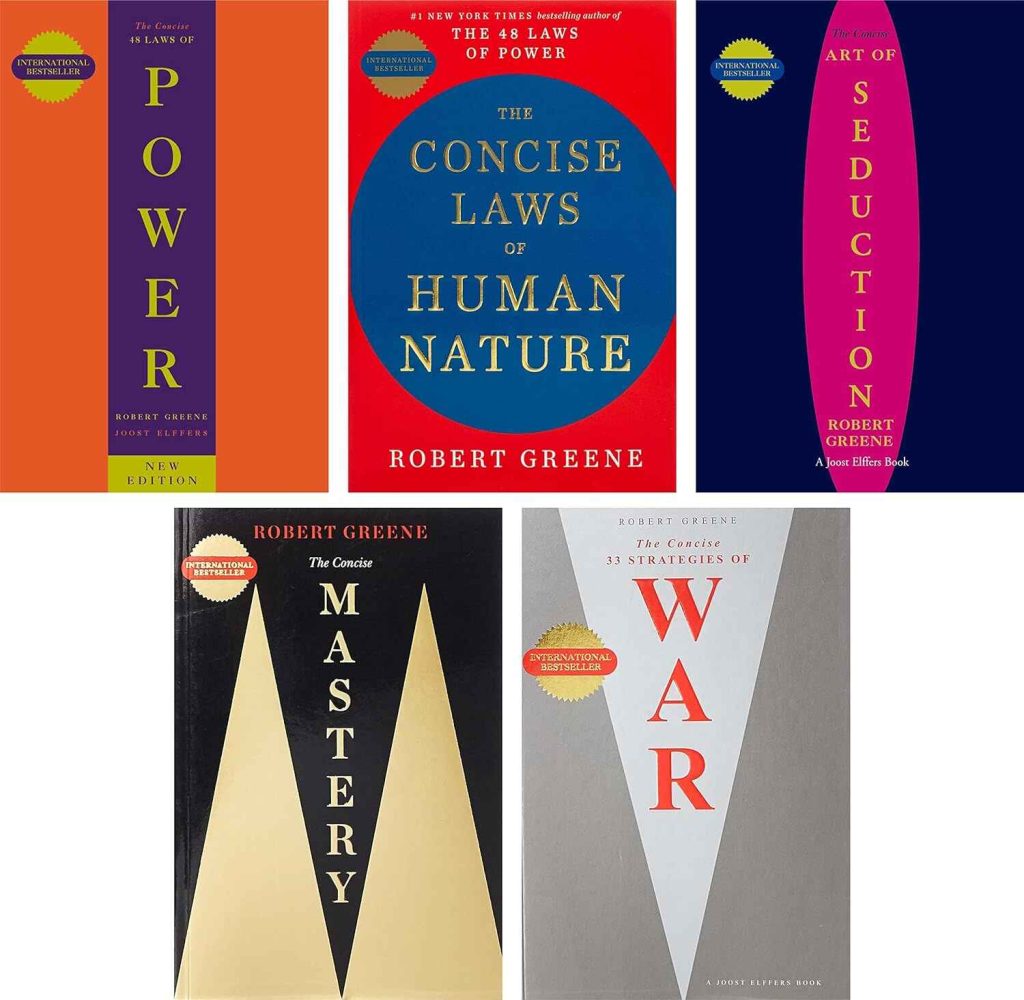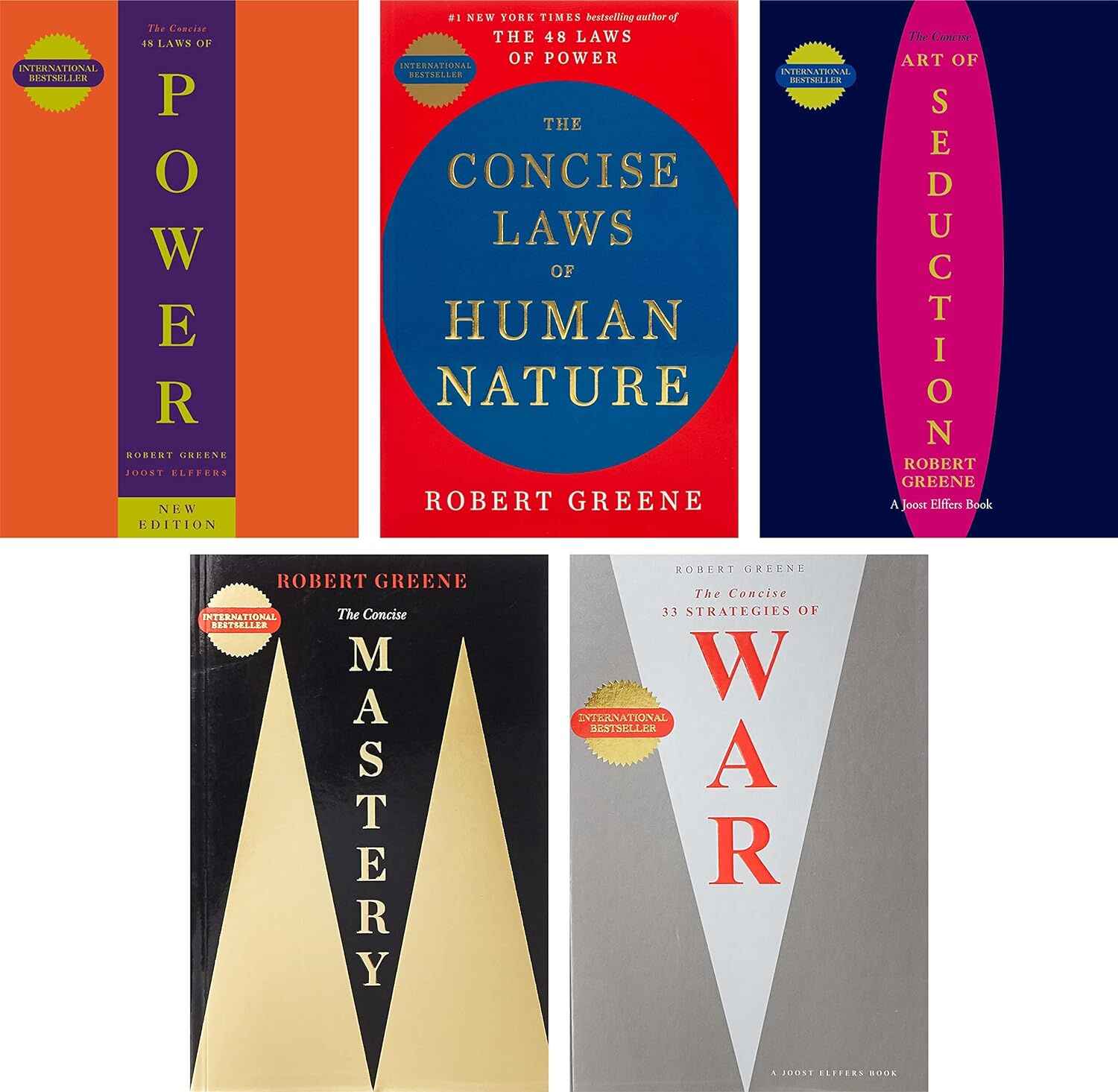The order in which you read Robert Greene’s books ultimately depends on your personal preferences, interests, and objectives. While there are suggestions for chronological or thematic sequences, there is no definitive right or wrong way to approach Greene’s works. Each book offers unique insights into human nature, power dynamics, and strategy, making them valuable reads in any order. Anyways, here’s the recommended order for reading Robert Greene’s books:
| Book Title | Published Date | Description |
| The 48 Laws of Power | 1998 | Strategies for gaining and maintaining power. |
| The Art of Seduction | 2001 | Tactics for persuasion and attraction. |
| The 33 Strategies of War | 2006 | Strategies for navigating conflicts and achieving goals. |
| The 50th Law | 2009 | Focuses on fearlessness and self-reliance. |
| Mastery | 2012 | Principles and practices for achieving mastery. |
| The Laws of Human Nature | 2018 | Examines human behavior and psychology. |
| The Daily Laws | 2021 | Offering daily insights and wisdom. |

In Which Order Should I Read Robert Greene Books?
Robert Greene is known for his books on power dynamics, strategy, and human behavior. While there isn’t a strict “best order” to read his books since they often cover different aspects of these themes, here’s a suggested sequence based on the complexity of the ideas presented and how they build upon each other:
“The 48 Laws of Power” (1998): Start with this foundational text to learn about power and how people have used it throughout history. It’s like a guidebook for understanding how to deal with powerful people and situations.
“The Art of Seduction” (2001): Next, read about Greene’s examination of seduction tactics, which complements the lessons of power from his first book. This book shows how people have influenced others through charm and persuasion. It’s helpful for understanding relationships and social dynamics.
“The 33 Strategies of War” (2006): Explore this book to learn about strategies from the battlefield that can be applied to everyday life. It’s like a toolbox of ideas for handling conflicts and challenges.
“The 50th Law” (2006, co-authored with 50 Cent): This book is a collaboration with rapper 50 Cent. It talks about facing fears and being strong in pursuit of your goals. It’s full of real-life stories and practical advice.
“Mastery” (2012): Shift focus to personal development with this exploration of the paths to excellence.Dive into this book to discover how people become really good at what they do. It’s like a roadmap for achieving excellence in any field by studying the lives of great achievers.
“The Laws of Human Nature” (2018): Conclude with Greene’s latest work, learn the complexities of human behavior and psychology. It’s like a guide to understanding yourself and others better, improving relationships and effective communication.
“The Daily Laws” (2021): Additionally, supplement your reading with “The Daily Laws,” a collection of daily insights drawn from Greene’s works. These brief lessons provide practical guidance for applying his principles in everyday life, enhancing your understanding and mastery of his teachings.
This sequential approach allows for a comprehensive exploration of Greene’s themes, moving from power dynamics and strategy to personal development and understanding human nature, with the added benefit of daily practical wisdom from “The Daily Laws.”
Are Robert Greene’s Books Worth Reading? Why or Why Not?
Robert Greene’s books are definitely worth reading, especially if you’re interested in understanding human behavior, power dynamics, and strategies for success. Here’s why:
Insight into Human Nature: Greene’s books delve deep into the complexities of human nature, exploring motivations, desires, and the psychology behind people’s actions. Whether it’s “The 48 Laws of Power,” “The Art of Seduction,” or “Mastery,” Greene provides readers with valuable insights into how individuals think and behave in various contexts.
Practical Strategies: One of the most compelling aspects of Greene’s books is their practicality. He doesn’t just offer theoretical concepts; he provides actionable strategies that readers can apply in their own lives. Whether you’re looking to navigate social situations, advance in your career, or pursue personal goals, Greene offers strategies that can help you achieve success.
Historical Examples: Greene often draws on historical examples to illustrate his points, which adds depth and context to his insights. By examining the successes and failures of historical figures, readers can gain a better understanding of timeless principles that apply to a wide range of situations.
Provocative Ideas: Greene’s books are known for challenging conventional wisdom and pushing readers to think differently. While some of his ideas may be controversial or uncomfortable, they encourage readers to question their assumptions and consider alternative perspectives. This can be both intellectually stimulating and personally enlightening.
Empowerment: Ultimately, Greene’s books are about empowerment. By understanding the dynamics of power, influence, and mastery, readers can take control of their own destinies and shape their lives according to their desires. Greene encourages readers to be proactive, strategic, and deliberate in their actions, rather than simply reacting to external forces.
Of course, it’s important to approach Greene’s books critically and with an awareness of their limitations. While his insights are often valuable, they should be tempered with an understanding of context and nuance. Additionally, some readers may find Greene’s writing style to be overly manipulative or cynical, so it’s important to read with a discerning eye.
Overall, however, Robert Greene’s books offer valuable lessons and insights for anyone interested in understanding human behavior and achieving success in their personal or professional lives. Whether you’re a student, entrepreneur, or simply someone looking to navigate the complexities of the world, Greene’s books have something to offer.
Final Words
So, start with “The 48 Laws of Power” as it lays a foundation for understanding power dynamics. Then proceed with “The Art of Seduction” for insights into social interaction. “The 33 Strategies of War” follows, offering strategic thinking. Next, “The 50th Law,” co-written with 50 Cent, delves into fearlessness. “Mastery” explores the path to expertise. Finally, “The Laws of Human Nature” covers understanding human behavior. Don’t forget to read ‘The daily laws’ to get an extra boost.
However, it’s not compulsory to follow the orders. Feel free to adapt this order to suit your interests and goals. Just trust your instincts, select the book that resonates with you most, and embark on an enriching exploration of the complex facets of the human experience as elucidated by Robert Greene.


4 thoughts on “In Which Order Should I Read Robert Greene Books?”